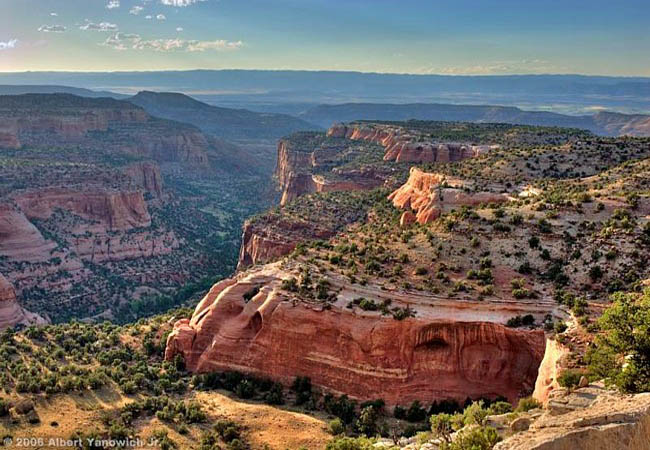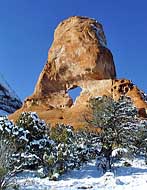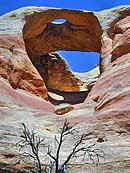|
Scenic USA - Colorado Rattlesnake Canyon |

| Photo by Albert Yanowich Jr. Inset Photos by Craig Shelly and Rob Jones |
Colorado's unique Black Ridge Canyons Wilderness takes  in 75,550 acres of the ancient Uncompahgre Plateau, a geological ridge created about 70 million years ago. Here, the free-flowing Colorado River has chiseled its way through miles of soft sandstone, creating Horsethief and Ruby canyons. An additional seven side canyons, from Fruita to the Utah border, make up some of the state's most spectacular canyonlands scenery.
in 75,550 acres of the ancient Uncompahgre Plateau, a geological ridge created about 70 million years ago. Here, the free-flowing Colorado River has chiseled its way through miles of soft sandstone, creating Horsethief and Ruby canyons. An additional seven side canyons, from Fruita to the Utah border, make up some of the state's most spectacular canyonlands scenery.
Bordering Interstate 70 and the Colorado River to the north, Rattlesnake Canyon holds nine major natural arches, one of the main reasons for its popularity. Keep in mind that this is wilderness land where access takes visitors over a rugged unpaved road to Mee Canyon and then out to the Rattlesnake Canyon trailhead. Alternate access routes require a challenging hike from western Fruita's Kings View Estates, leading backpackers  seven miles over the Pollack Bench Trail. Either route leads to adventure in this section of McInnis Canyons NCA, a trip through a small section of the vast and beautiful Colorado Plateau. Also viewed as a trail back in time, western Colorado is a land where dinosaurs roamed and fossil evidence is found. Paleo-Indians hunted and gathered food here 13,000 years ago, and more recently members of the Fremont culture, responsible for the majority of rock art and pictographs, called the area home around year 500 CE.
seven miles over the Pollack Bench Trail. Either route leads to adventure in this section of McInnis Canyons NCA, a trip through a small section of the vast and beautiful Colorado Plateau. Also viewed as a trail back in time, western Colorado is a land where dinosaurs roamed and fossil evidence is found. Paleo-Indians hunted and gathered food here 13,000 years ago, and more recently members of the Fremont culture, responsible for the majority of rock art and pictographs, called the area home around year 500 CE.
Whether you decide on backpacking in solitude, floating through the beauty of Ruby Canyon, or camping in Rabbit Valley, this national conservation land offers unmatched experiences in a wild and untrammeled canyonland.
Area Map
BLM Map

|
Additional Area Attractions |
|
Copyright © 2021 Benjamin Prepelka
All Rights Reserved
